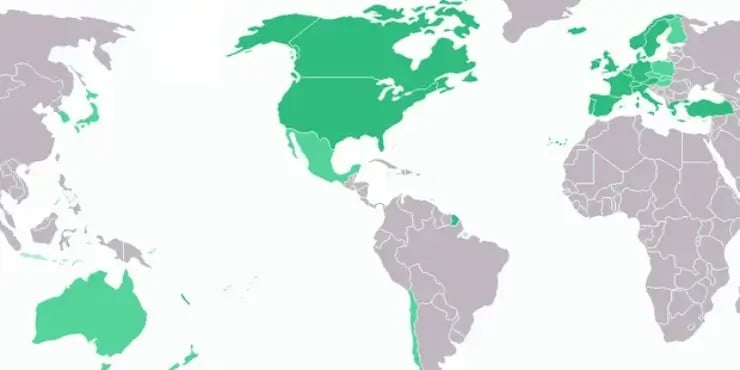Continued degradation and erosion of natural environmental capital is expected to 2050, with the risk of irreversible changes that could endanger two centuries of rising living standards.
What sounds like a new warning by the classic Club of Rome, is actually not a statement delivered by concerned scientists. Instead, it is one of the outcomes of a meeting where Environment Ministers of the world’s 34 richest countries came together. Under the catchy title “Making Green Growth Deliver”, the OECD Environment Policy Committee (EPOC) evaluated the OECD Environmental Strategy, which was put on the political agenda eleven years ago. As the introductory statement reveals, the strategy is focused on a timescale of 50 years, evaluating the last ten and the next 40 years from now. By the way, in order to avoid any misunderstandings, EPOC is not to be confused with OPEC…
Citizens, Business or State – Who Is Responsible For Taking Environmental Action?
There are many discussions centered around the challenge of bringing economic growth into accordance with ecological respect. In a nutshell, it all comes down to three standpoints. In my opinion, in anticipation of the right answer, all three standpoints are correct: Some argue that a new global citizenship should evolve, requiring each individual to realize a radical personal change in consumption and life style. Others call for decision makers in the business world to improve technology and offer greener products. A third point of view, which focuses on the responsibility of neither individuals nor business, calls for new rules, institutions and policies. It is not surprising that environment ministers, as representatives of the political class, consider the latter – political action – the most important one.
OECD: Growth Hinders Environmental Improvement
However, the documents that EPOC’s assumptions are based on draw an extreme picture. The harshness describing the way economic development threatens environmental capital seems unusual for an economic institution so dedicated to development that its very name incorporates that word. But in the “OECD Environmental Outlook to 2050″, the Organization for Economic Co-operation and Development calls for a radical change in political direction.
Without new policies, progress in reducing environmental pressures will continue to be overwhelmed by the sheer scale of growth.
Now, just as for new technologies, there is no lack of incentives for new policies. The fundamental problem, from my point of view, is not a desperate need for ideas, but rather a need for their implementation. All of the OECD countries have an official governmental institution for the environment. Some are called Environment Ministries, some Environment Departments. What they all have in common, is the lower priority with which their proposals are realized in comparison to other ministries. In 99 out of 100 cases, it is not the Environment Minister, but the Economy Minister that has the last word. When it comes to this lack of power, EPOC returns to polite and diplomatic terms and the unification of the above mentioned three standpoints becomes evident:
There is an urgent need for more ambitious policies to tackle environmental pressures. But such policies will only be acceptable and effective if they demonstrate that they take full account of economic and social considerations. For this reason, the active engagement of other Ministers will be essential, including those responsible for Finance, Economy and Trade, as well as the private sector, trade unions and NGOs.
80% More Energy Consumption in 2050
Why do we need more ambitious policies? First, because the world will not be the same in 2050. Certainly, it will not be like 1850 when unconstrained industrialization began and no limit was in sight. Second, because the western lifestyle, let’s say the current, high energy-consumption form of the western lifestyle, the one that more and more people strive to live, is not practicable for the majority of mankind. People in “the developed world” simply consume too much of the limited resources the planet offers.
By 2050, the Earth’s population is expected to increase from 7 billion to over 9 billion and the world economy is projected to nearly quadruple, with growing demand for energy and natural resources as a result. (…) A world economy four times larger than today is projected to use 80% more energy in 2050. (…) Nearly 70% of the world’s population is projected to live in urban areas by 2050, exacerbating challenges such as air pollution, transport congestion, and waste management.
66% More GHG Emissions
In its business-as-usual scenario, which the Outlook to 2050 report defines as conditions “without more ambitious policies”, it was forecast that in 2050, 80% more energy will be consumed, which will result in a 66% rise of greenhouse gas emissions compared to 2010. This increase is mainly caused by enormous growth rates in the six countries referred to as BRIICS. The biggest share of the 66% increase in GHG emissions goes to development in China, India, Brazil, Indonesia and South Africa, marked in light green in the following graphic. Note that even though Russia belongs to the BRIICS countries, it is listed separately.

A comprehensive summary of trends, based on both a business-as-usual scenario and a taking-action scenario, is provided by the report’s Key Facts and Figures. Concerning Climate Change, there is a clear message:
Delaying action is costly. Delayed or only moderate action up to 2020 (such as implementing the Copenhagen/Cancún pledges only, or waiting for better technologies to come on stream) would increase the pace and scale of efforts needed after 2020. It would lead to 50% higher costs in 2050 compared to timely action, and potentially entail higher environmental risk.
Too Many Fossil Fuels, Too Many Cars
The “Outlook to 2050″ report refers to global problems and global challenges. The EPOC meeting “Making Green Growth Deliver”, which took place on March 29th and March 30th in Paris, however, dealt with the OECD countries only. It made the criticism that the energy mix in OECD countries is still 80% based on fossil fuels. Moreover, urban air quality is in decline and poses a threat to our health. A closely related trend is the continuous increase in motorization. The result is known as the rebound-effect:
The environmental gains associated with more fuel-efficient, less-polluting motor vehicles have been overwhelmed by the increased scale of their use, which is related to the continued dominance of motor vehicles in the modal split, urban sprawl, and the expansion of motorways;
Even the Greenest Are Not Green Enough
Some countries, presumably Scandinavian ones and Germany, rank better than others concerning their policy shifts toward sustainability. However, even the measures taken by these countries are insufficient:
[If] all OECD countries converged with the performance of the “top-runners”, the overall performance of OECD countries would be substantially improved. However, even this would not be enough to decouple environmental pressures from economic growth in absolute terms.
And here is the structural problem that most of us know of. Read it carefully, black letters on white background. This is the OECD speaking. Yes, this is the official voice of the developed world:
A key factor is that prices still do not sufficiently internalize environmental costs; and some subsidies create perverse incentives for environmentally harmful activities. Natural assets are consistently undervalued in conventional economic analysis and decision making. As a result, there is a gap between private returns from economic activity and the overall benefits that accrue to society.
Why is that so?
Current economic structures, and the associated patterns of production and consumption, are reinforcing the dominance of existing technologies, infrastructure and related institutions. These are formidable barriers to the transition to a low-carbon, more resource-efficient economy. Overcoming this inertia will require substantial innovation, not just in technologies but also in the social and institutional relations in which they are embedded.
Who Covers the Cost?
And who should pay the bill? Innovation is costly, and spending money in times of crisis seems to be difficult. However, in contrast to what it may seem to say, the report cleverly concludes there is indeed room for innovation right now:
While governments are facing severe pressures to reduce budget deficits, there are nevertheless opportunities for environment-related policies to contribute to fiscal consolidation (by removing environmentally harmful subsidies and shifting the tax burden from capital and labour to environment), and to improving productivity and competitiveness (by driving innovation, more efficient technologies, and related employment opportunities).
There is no reason not to shift to a low-carbon economy. There is not the slightest justification not to invest in green technology. I say that with solid conviction, and I am happy to have the backup of an institution representing the 34 richest economies:
Moreover, the messages from the OECD Environmental Outlook to 2050 are clear: if we do not take policy action to address the key environmental challenges, the costs of inaction to the economy and human well-being of over-use of natural resources, pollution and waste will be significant. With cost-effective policies, the costs of action now are likely to be much lower than the costs of delayed action or inaction in a number of areas.
Article image CC 2.0 BY SA, edited by Moritz Bühner, taking this Wikimedia Commons image as a source.





